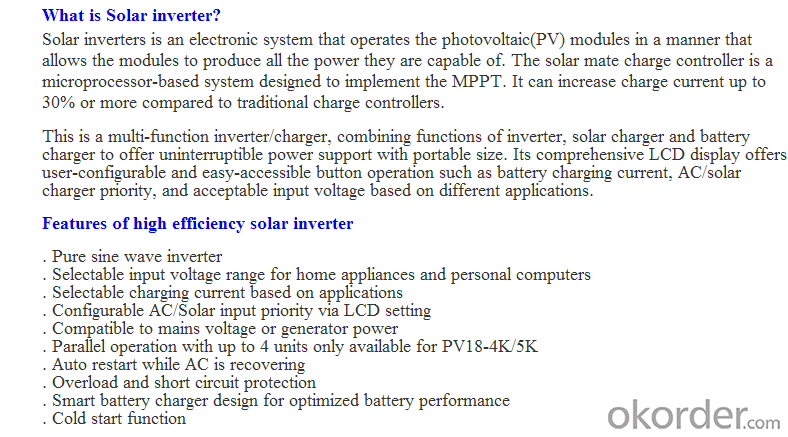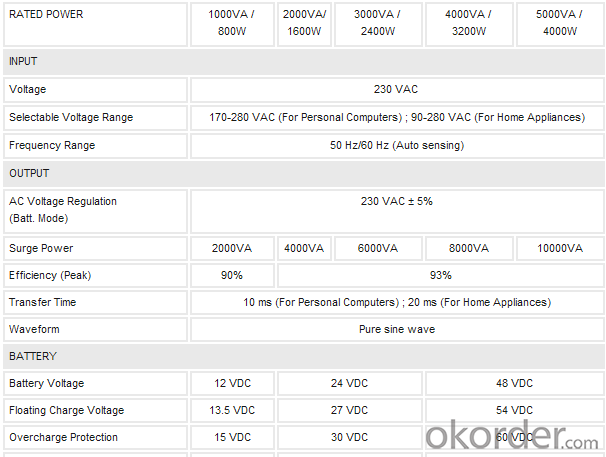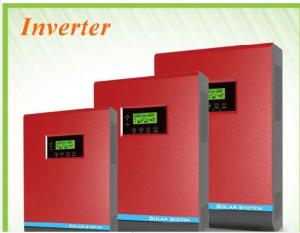On Grid Solar Inverter GS1500-SS
- Loading Port:
- Shanghai
- Payment Terms:
- TT or LC
- Min Order Qty:
- 10 unit
- Supply Capability:
- 100 unit/month
OKorder Service Pledge
OKorder Financial Service
You Might Also Like
Description:
GW1500-SS photovoltaic inverter is suitable for home rooftop photovoltaic system, designed under modern industrial concept. There are three colors for option with fashionable appearance. This model is applicable for the photovoltaic system with open-circuit voltage less than 450V, maximum output power less than 1800W. Its maximum conversion efficiency can reach 97%. First-class harmonic control ability, small size and light weight make it hold a safe lead among similar products.



FAQ:What's your warranty?
Our warranty is 1 year
- Q:What is the maximum number of solar panels that a solar inverter can support?
- The maximum number of solar panels that a solar inverter can support depends on the capacity and specifications of the specific inverter model. There is no universal limit, as different inverters have different capabilities, but typically, a solar inverter can support anywhere from a few panels to several hundred panels. It is important to consult the manufacturer's guidelines and technical specifications to determine the maximum number of panels that a particular solar inverter can handle.
- Q:What are the common fault indications in a solar inverter?
- Some common fault indications in a solar inverter include error codes displayed on the inverter's screen, abnormal or fluctuating power output, frequent tripping or shutting down of the inverter, unusual noises or vibrations, and failure to connect or communicate with the monitoring system. These fault indications often suggest issues such as overheating, overvoltage, overcurrent, ground faults, or component failure within the inverter.
- Q:Can a solar inverter be used in areas with high humidity and salt air exposure?
- Certainly, a solar inverter can indeed be utilized in regions characterized by elevated humidity levels and salt air exposure. Nevertheless, it is imperative to opt for a solar inverter explicitly engineered to withstand such circumstances. The presence of high humidity has the potential to induce corrosion and harm electronic components, while salt air exposure can expedite corrosion due to the corrosive properties of salt. Consequently, it is vital to choose an inverter constructed from corrosion-resistant materials, such as stainless steel or coated circuit boards. Furthermore, consistent maintenance and cleaning of the inverter are essential to guarantee optimal performance and longevity in such environments.
- Q:Can a solar inverter be used with a single solar panel?
- Yes, a solar inverter can be used with a single solar panel. The purpose of a solar inverter is to convert the direct current (DC) generated by the solar panel into usable alternating current (AC) electricity. Whether you have one or multiple solar panels, a solar inverter is necessary to convert the DC power into AC power that can be used to power electrical appliances or be fed back into the grid.
- Q:How does a solar inverter handle ground fault protection?
- A solar inverter handles ground fault protection by continuously monitoring the flow of current between the solar panel array and the ground. If it detects any abnormal current leakage or ground faults, it quickly shuts down the system to prevent any potential electrical hazards or damage.
- Q:What are the installation requirements for a solar inverter?
- The installation requirements for a solar inverter typically include a suitable mounting location, proper ventilation, and a stable electrical connection. The inverter should be installed in a shaded area, away from direct sunlight and extreme temperatures. It should be mounted securely on a sturdy surface, such as a wall or a rack. Adequate ventilation is necessary to dissipate heat generated during operation. Additionally, the inverter must be connected to the electrical panel or grid with the appropriate wiring and circuit breakers, following local electrical codes and regulations.
- Q:Can a solar inverter provide power during a blackout?
- No, a solar inverter cannot provide power during a blackout. This is because solar inverters are designed to convert the direct current (DC) electricity generated by solar panels into alternating current (AC) electricity for use in homes or businesses. However, during a blackout, the solar panels cannot generate electricity since the grid connection is lost, and therefore the solar inverter cannot provide power.
- Q:How does a solar inverter handle voltage fluctuations?
- A solar inverter handles voltage fluctuations by continuously monitoring the incoming solar power and adjusting its output voltage accordingly. It uses advanced electronics and control algorithms to ensure that the output voltage remains stable and within a specified range, regardless of variations in the input voltage. This allows it to provide a consistent and safe supply of electricity to connected devices, even in the presence of voltage fluctuations.
- Q:What are the safety features of a solar inverter?
- The safety features of a solar inverter typically include surge protection, overvoltage protection, short circuit protection, ground fault detection, and overtemperature protection. These features help to prevent damage to the inverter and the electrical system, ensuring safe and reliable operation.
- Q:Can a solar inverter be used with a solar-powered electric vehicle charging station?
- Yes, a solar inverter can be used with a solar-powered electric vehicle charging station. The solar inverter helps convert the direct current (DC) power produced by the solar panels into alternating current (AC) power that can be used to charge electric vehicles. This allows for efficient and sustainable charging of electric vehicles using solar energy.
1. Manufacturer Overview |
|
|---|---|
| Location | |
| Year Established | |
| Annual Output Value | |
| Main Markets | |
| Company Certifications | |
2. Manufacturer Certificates |
|
|---|---|
| a) Certification Name | |
| Range | |
| Reference | |
| Validity Period | |
3. Manufacturer Capability |
|
|---|---|
| a)Trade Capacity | |
| Nearest Port | |
| Export Percentage | |
| No.of Employees in Trade Department | |
| Language Spoken: | |
| b)Factory Information | |
| Factory Size: | |
| No. of Production Lines | |
| Contract Manufacturing | |
| Product Price Range | |
Send your message to us
On Grid Solar Inverter GS1500-SS
- Loading Port:
- Shanghai
- Payment Terms:
- TT or LC
- Min Order Qty:
- 10 unit
- Supply Capability:
- 100 unit/month
OKorder Service Pledge
OKorder Financial Service
Similar products
New products
Hot products
Hot Searches
Related keywords
































